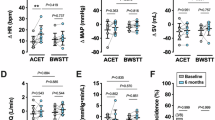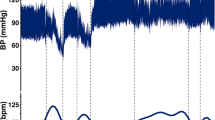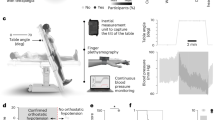Abstract
Study design:
Prospective study of two cases.
Objectives:
To describe the effects of electrical stimulation (ES) therapy in the 4-week management of two sub-acute spinal cord-injured (SCI) individuals (C7 American Spinal Injury Association Impairment Scale (AIS) B and T9 AIS (B)).
Setting:
University Malaya Medical Centre, Kuala Lumpur, Malaysia.
Methods:
A diagnostic tilt-table test was conducted to confirm the presence of orthostatic hypotension (OH) based on the current clinical definitions. Following initial assessment, subjects underwent 4 weeks of ES therapy 4 times weekly for 1 h per day. Post-tests tilt table challenge, both with and without ES on their rectus abdominis, quadriceps, hamstrings and gastrocnemius muscles, was conducted at the end of the study (week 5). Subjects’ blood pressures (BP) and heart rates (HR) were recorded every minute during pre-test and post-tests. Orthostatic symptoms, as well as the maximum tolerance time that the subjects could withstand head up tilt at 60°, were recorded.
Results:
Subject A improved his orthostatic symptoms, but did not recover from clinically defined OH based on the 20-min duration requirement. With concurrent ES therapy, 60° head up tilt BP was 89/62 mm Hg compared with baseline BP of 115/71 mm Hg. Subject B fully recovered from OH demonstrated by BP of 105/71 mm Hg during the 60° head up tilt compared with baseline BP of 124/77 mm Hg. Both patients demonstrated longer tolerance time during head up tilt with concomitant ES (subject A: pre-test 4 min, post-test without ES 6 min, post-test with ES 12 min; subject B: pre-test 4 min, post-test without ES 28 min, post-test with ES 60 min).
Conclusions:
Weekly ES therapy had positive effect on OH management in sub-acute SCI individuals.
Similar content being viewed by others
Log in or create a free account to read this content
Gain free access to this article, as well as selected content from this journal and more on nature.com
or
References
Guyenet PG . The sympathetic control of blood pressure. Nat Rev Neurosci 2006; 7: 335–346.
Chao CY, Cheing GL . Orthostatic hypotension for people with spinal cord injuries. Hong Kong Physiother J 2008; 26: 51–58.
Claydon VE, Steeves JD, Krassioukov A . Orthostatic hypotension following spinal cord injury: understanding clinical pathophysiology. Spinal Cord 2006; 44: 341–351.
Illman A, Stiller K, Williams M . The prevalence of orthostatic hypotension during physiotherapy treatment in patients with an acute spinal cord injury. Spinal Cord 2000; 38: 741–747.
Raymond J, Davis GM, Bryant G, Clarke J . Cardiovascular responses to an orthostatic challenge and electrical-stimulation-induced leg muscle contractions in individuals with paraplegia. Eur J Appl Physiol Occup Physiol 1999; 80: 205–212.
Raymond J, Davis GM, van der Plas MN, Groeller H, Simcox S . Carotid baroreflex control of heart rate and blood pressure during ES leg cycling in paraplegics. J Appl Physiol 2000; 88: 957–965.
Sampson EE, Burnham RS, Andrews BJ . Functional electrical stimulation effect on orthostatic hypotension after spinal cord injury. Arch Phys Med Rehabil 2000; 81: 139–143.
Demchak TJ, Linderman JK, Mysiw WJ, Jackson R, Suun J, Devor ST . Effects of functional electric stimulation cycle ergometry training on lower limb musculature in acute SCI individuals. J Sports Sci Med 2005; 4: 263–271.
Chao CY, Cheing GL . The effects of lower-extremity functional electric stimulation on the orthostatic responses of people with tetraplegia. Arch Phys Med Rehabil 2005; 86: 1427–1433.
Taylor PN, Tromans AM, Harris KR, Swain ID . Electrical stimulation of abdominal muscles for control of blood pressure and augmentation of cough in a C3/4 level tetraplegic. Spinal Cord 2002; 40: 34–36.
Faghri PD, Yount J . Electrically induced and voluntary activation of physiologic muscle pump: a comparison between spinal cord-injured and able-bodied individuals. Clin Rehabil 2002; 16: 878–885.
Yoshida T, Masani K, Sayenko DG, Miyatani M, Fisher JA, Popovic MR . Cardiovascular response of individuals with spinal cord injury to dynamic functional electrical stimulation under orthostatic stress. IEEE Trans Neural Syst Rehabil Eng 2013; 21: 37–46.
Elokda AS, Nielsen DH, Shields RK . Effect of functional neuromuscular stimulation on postural related orthostatic stress in individuals with acute spinal cord injury. J Rehabil Res Dev 37: 535–542.
Chi L, Masani K, Miyatani M, Thrasher TA, Johnston KW, Mardimae A et al. Cardiovascular response to functional electrical stimulation and dynamic tilt table therapy to improve orthostatic tolerance. J Electromyogr Kinesiol 2008; 18: 900–907.
Czell D, Schreier R, Rupp R, Eberhard S, Colombo G, Dietz V . Influence of passive leg movements on blood circulation on the tilt table in healthy adults. J Neuroeng Rehabil 2004; 1: 4.
Schatz IJ, Bannister R, Freeman RL, Goetz CG, Jankovic J, Kaufmann HC et al. Consensus statement on the definition of orthostatic hypotension, pure autonomic failure, and multiple system atrophy. Neurology 1996; 46: 1470.
Krenz NR, Meakin SO, Krassioukov AV, Weaver LC . Neutralizing intraspinal nerve growth factor blocks autonomic dysreflexia caused by spinal cord injury. J Neurosci 1999; 19: 7405–7414.
Acknowledgements
We thank Ms T Noor Rabihah T Mahamed for help with edits and referencing. This research was fully supported by the Ministry of Higher Education, Malaysia and University of Malaya through High Impact Research (HIR) Grant No. UM.C/625/1/HIR/MOHE/ENG/39.
Author information
Authors and Affiliations
Corresponding author
Ethics declarations
Competing interests
The authors declare no conflict of interest.
Rights and permissions
About this article
Cite this article
Hamzaid, N., Tean, L., Davis, G. et al. Electrical stimulation-evoked contractions blunt orthostatic hypotension in sub-acute spinal cord-injured individuals: two clinical case studies. Spinal Cord 53, 375–379 (2015). https://doi.org/10.1038/sc.2014.187
Received:
Revised:
Accepted:
Published:
Issue date:
DOI: https://doi.org/10.1038/sc.2014.187



